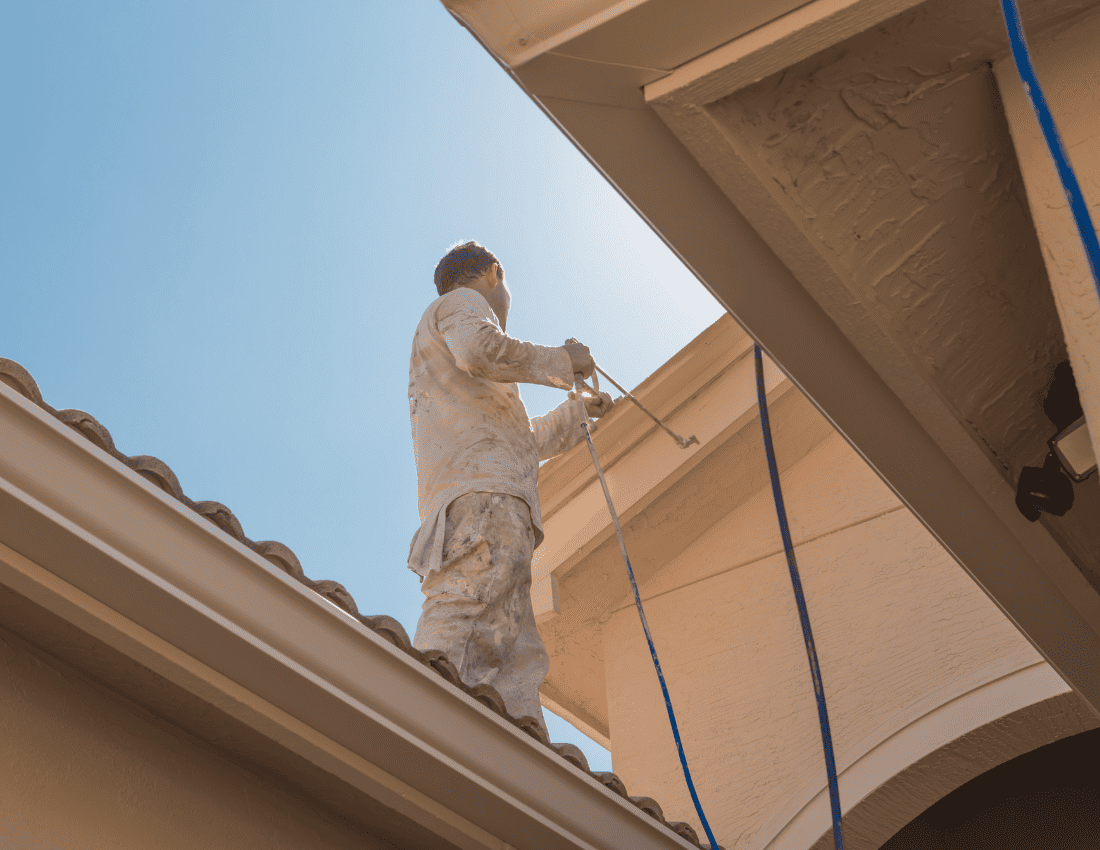If you’re planning a painting project, one of the biggest choices you’ll make is roller painting vs spray painting. Each method has its perks, and your decision can affect everything from the finish to the time it takes to complete the job.
Some homeowners swear by paint sprayers for their ability to coat large areas quickly and leave behind a smooth, professional-looking finish. Others prefer paint rollers, which give better control, waste less paint, and work well for interior walls and ceilings.
So, which one is right for your home in Elkhorn, NE?
Whether you’re painting walls, cabinets, ceilings, or exterior siding, knowing when to use a sprayer or roller makes all the difference.
Professional painters often use both techniques, depending on the surface and project size. Today, we’re breaking it all down—where each method works best, its challenges, and how to get the most out of your next painting project.
Key Takeaways:
- A paint sprayer is best for large areas, textured surfaces, and intricate details, delivering a smooth, even finish but requiring more prep work and paint.
- A paint roller offers better control with less mess, making it ideal for interior walls, ceilings, and budget-friendly projects.
- Sprayers require extensive masking to prevent overspray on floors, furniture, and windows, while rollers need minimal setup.
- Rollers are more cost-effective since they apply paint directly to the surface, while sprayers tend to use more paint due to fine mist loss.
- For detailed furniture, cabinetry, or textured walls, a sprayer is the best option. If you want even coverage with easy application, a roller is the way to go.
When to Use a Paint Sprayer

Paint sprayers use compressed air or high-pressure pumps to turn paint into a fine mist that coats surfaces evenly. This method is a favorite among professional painters for its efficiency and flawless finish.
Best for Large, Open Spaces
When painting garage doors, exterior siding, fences, brick walls, or stucco, a paint sprayer is the most efficient tool for the job. It delivers a smooth, even finish in a fraction of the time compared to a roller. Instead of going back and forth multiple times, you can coat large areas quickly with minimal effort.
But while sprayers speed up application, they also require more prep work. Because overspray is unavoidable, you’ll need to take extra precautions to protect surrounding areas. Floors, windows, baseboards, furniture, and even landscaping should be covered with plastic sheeting, drop cloths, or painter’s tape.
If you’re working outdoors, be mindful of wind conditions—paint mist can travel farther than expected and land on concrete walkways, neighboring homes, or garden plants. Sprayers are great for open spaces, but they demand careful planning to avoid unintentional messes.
Perfect for Textured or Detailed Surfaces
Sprayers are an excellent choice when painting surfaces with grooves, rough textures, or intricate details. Unlike rollers, which struggle to get paint into crevices, a sprayer ensures even coverage on hard-to-reach surfaces.
It works especially well on:
- Popcorn ceilings & textured drywall. Rollers can leave uneven patches, but a sprayer evenly coats every corner.
- Brick & masonry. Paint easily settles into cracks and crevices, eliminating the need for excessive rolling or brushing.
- Crown molding & baseboards. A sprayer covers fine details seamlessly without leaving brush marks.
If you’re painting kitchen cabinets or furniture, a sprayer is also your best bet. It lays down an ultra-smooth, factory-like finish that’s hard to achieve with a roller or brush. This makes it ideal for refinishing cabinetry, built-in shelving, or decorative woodwork where a sleek, professional look is key.
Need help choosing the right colors? Interior painting ideas can guide you through stylish and timeless options for your space.
Challenges of Using a Paint Sprayer
While a paint sprayer offers an impressive finish and cuts down on painting time, it’s not without its challenges.
Requires More Masking & Preparation
One of the biggest drawbacks of spray painting is the extensive prep work involved. Unlike a paint roller, which applies paint only where you roll, a sprayer disperses a fine mist that can drift onto unintended surfaces.
This means spending extra time:
- Covering floors, furniture, and fixtures with drop cloths or plastic sheeting
- Taping off windows, doors, and baseboards to prevent overspray
- Wearing a mask and personal protective equipment to avoid inhaling airborne paint particles
For interior projects, this extra masking can feel overwhelming, especially if you’re only painting a single wall or a small section of a room. In such cases, using a roller might save you time and hassle.
Uses More Paint
Paint sprayers tend to use more paint than rollers due to overspray and thinner application. This means you might need extra gallons to complete your project, increasing your overall material costs.
Some reasons for increased paint consumption include:
- Paint mist floating away before reaching the surface
- Absorbent materials like stucco or brick soaking up extra paint
- Needing multiple coats to ensure full coverage
If you’re working on a budget, a paint roller is often the more economical choice, especially for interior walls or rooms where paint efficiency matters.
When a Paint Roller is the Best Choice

For most interior painting projects, a paint roller is the go-to tool. It’s reliable, easy to use, and wastes less paint.
Better Control with Less Mess
One of the biggest advantages of using a paint roller is the level of control it offers. Unlike a paint sprayer, which can send mist floating through the air, a roller applies paint directly onto the surface, reducing the risk of drips and overspray.
This makes a roller ideal for indoor spaces where clean, even coverage is important. House painters in Elkhorn, NE often recommend rollers for living rooms, bedrooms, and basements because they provide a consistent finish without requiring the extensive masking that comes with a sprayer.
Another benefit? You don’t have to worry about paint settling on furniture, carpet, or baseboards as long as you use a steady hand, the roller keeps the paint where you want it.
More Cost-Effective
A paint roller is also a budget-friendly choice, especially if you’re mindful of paint consumption. Since a roller presses paint directly onto the wall, it ensures maximum coverage with minimal waste.
By contrast, a sprayer atomizes paint into tiny particles, and some of that mist never makes it onto the surface. This leads to higher material costs, particularly if you’re working with oil-based paint, primer, or waterproofing products that require multiple coats for durability.
For homeowners who want to maximize coverage without overspending, a roller is a practical choice. It applies paint efficiently, cutting down on waste and reducing the need for extra gallons—a big plus for budget-conscious projects.
The type of paint you choose also plays a role in coverage and durability. Read our guide on the best paint for interior spaces to help you find the best fit for your project.
Great for Interior Walls & Ceilings
If you’re painting an occupied home, a paint roller is a practical and hassle-free option. Unlike a sprayer, which requires covering every inch of the room with plastic sheeting, rollers allow you to paint without the need for extensive masking.
This makes them a great choice for:
- Small projects like an accent wall or touch-ups
- Occupied homes where moving furniture isn’t an option
- Ceilings and hallways where overspray could settle on unintended surfaces
Rollers also give you the flexibility to pause and resume the project without worrying about paint drying inside a sprayer nozzle or spending extra time cleaning spray equipment between coats.
Challenges of Roller Painting
Although paint rollers are easy to use, they do have some downsides, depending on the project.
Takes Longer
If you’re painting a large surface like a garage door, exterior siding, or stucco wall, a roller will take considerably more time compared to a sprayer.
Instead of quick, even passes, you’ll need to reload the roller frequently, apply multiple coats, and work section by section. This can be time-consuming and physically demanding, especially for projects that involve ceilings or tall walls where an extension pole is needed.
Struggles with Textured Surfaces
Rollers work well on smooth walls, but they don’t always perform as well on textured materials. If you’re painting brick, stucco, or rough wood paneling, the roller may glide over the surface without reaching deep into crevices or uneven areas.
To get full coverage on textured surfaces, you may need:
- A high-nap roller that holds more paint and can reach into grooves
- Multiple coats to build up a solid layer of color
- A brush for touch-ups in areas the roller can’t fully reach
If you’re looking for ways to maintain your freshly painted walls, check out the interior painting maintenance guide for long-term care tips.
Roller Painting vs Spray Painting: Quick Comparison
To make the best choice, it helps to compare both side by side. The table below breaks down the key differences so you can decide which method fits your project.
| Factor | Paint Sprayer | Paint Roller |
|---|---|---|
| Best For | Large surfaces, textured walls, detailed molding | Interior walls, ceilings, and occupied spaces |
| Speed | Fast application, covers large areas quickly | Slower, requires multiple coats |
| Finish Quality | Smooth, factory-like, ideal for cabinets & furniture | Even coverage with slight texture |
| Paint Usage | Uses more paint due to overspray | Uses less paint, more cost-effective |
| Prep Work | Requires extensive masking and taping | Minimal masking needed |
| Ease of Use | Requires skill to avoid drips and uneven coats | Beginner-friendly, easy to control |
| Cost | Higher due to extra paint consumption & prep materials | More budget-friendly, less paint waste |
| Best for Textured Surfaces | Ideal for popcorn ceilings, brick, stucco | May require multiple coats or high-nap roller |
| Convenience | Needs proper ventilation and protective equipment | Can be done with minimal setup |
| Cleanup | Requires thorough cleaning of nozzles and hoses | Simple cleanup with roller tray and cover |
Both methods have their advantages, but choosing the right one depends on your project size, surface type, and budget.
House Painters in Elkhorn, NE: Our Painting Process & How We Can Help
At Kieser's Painting, we provide professional painting services in Ralston, Richfield, Waterloo, NE, and the surrounding areas.
What We Offer
- Expert Surface Prep. We clean, sand, and repair walls, drywall, masonry, and plaster for long-lasting results.
- Precision Masking & Protection. We cover floors, baseboards, windows, and furniture to prevent unwanted paint splatter.
- Skilled Application. Our professional painters in Elkhorn NE choose the right method—rollers, sprayers, or brushes—for a flawless finish.
- Final Touch-Ups & Cleanup. We leave your space neat and polished so you can enjoy the results right away.
Call us at 402-866-8260 for a FREE estimate today!

